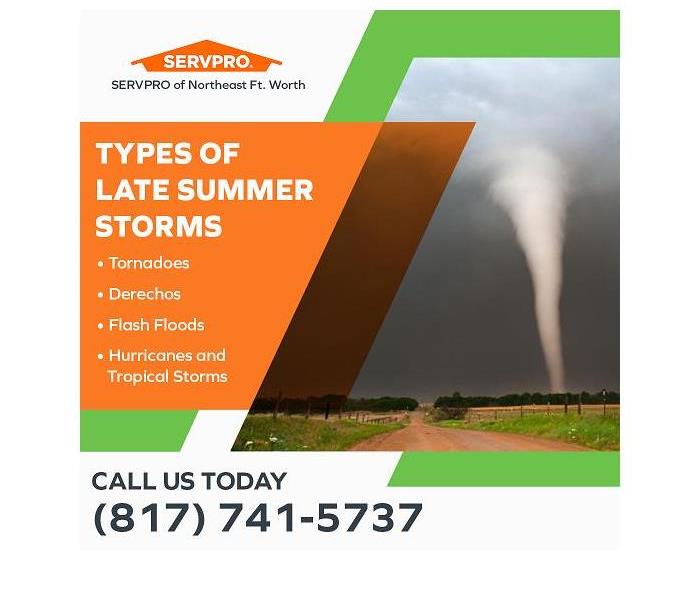Storm Damage Cleanup for Property Damage Caused by Late Summer Storms
9/5/2022 (Permalink)
Blog Summary: SERVPRO of Northeast Fort Worth provides damage restoration services for storm damage stemming from late summer tornadoes, derechos, hurricanes, and flash flooding.
SERVPRO of Northeast Fort Worth is dedicated to assisting homeowners and businesses recover from storm damage in Keller, TX. A knowledge of the types of late summer storms that can cause storm damage in Keller, TX, can help residents be prepared and know what kinds of damage to look for after the severe weather.
Types of Late Summer Storms
Residents of Keller, TX, and Northeast Fort Worth can experience severe weather in late summer. Weather experts describe the severe weather risk hazard: “Tornado risk persists in late summer, especially in parts of the northern tier. Derechos can still result in widespread destruction. The Southwest monsoon lasts through September and brings several hazards. Flash flooding concerns remain high through late summer. The peak of hurricane season occurs in late summer. Severe weather, including tornadoes, derechos, and flash flooding, can result in dangerous conditions through late summer in parts of the United States.”
Below is a closer look at several types of severe weather that can cause property damage in the Northeast Fort Worth area.
Tornadoes
Thankfully, by late summer, the frequency of tornadoes in North Texas is on the decline, though a real and present danger still exists any time tornadic weather is in the forecast. The presence of a hurricane barreling through the region may cause an uptick in the frequency of tornadoes during the months of August and September.
Derechos
The Spanish word “derecho” means “direct” or “straight ahead.” The term was adopted to make a distinction between the damage caused by straight-line winds and the damage produced by the rotational winds of tornadoes. A derecho is a large cluster of severe thunderstorms with straight-line winds. Windspeeds must be at least 58 miles per hour for a storm pattern to be considered a derecho; some derecho windspeeds have been clocked at 130 miles per hour. The damage path of a derecho can be tens of miles wide and hundreds of miles long.
Flash Floods
In the United States, flash flooding reaches its peak in late spring and continues through summer. Warm, moist air east of the Rockies, combined with the Southwest monsoon effect and the occurrence of hurricanes and tropical storms, creates a convergence that increases moisture levels and heightens the risk of flash flooding. Flash flooding can be experienced within minutes of heavy rainfall. On average, more fatalities occur from flash floods than from hurricanes and tornadoes. Most flash flooding deaths occur while the victim is driving.
Hurricanes and Tropical Storms
June through November are the official dates of the Atlantic hurricane season, but the peak of the season occurs in late summer. These turbulent, dynamic storm systems produce heavy rains resulting in flooding and can also generate tornadoes. In 2004, Hurricane Ivan spawned the most tornadoes on record, 120 over nine states, and in 1967, Hurricane Beulah left 115 known tornadoes in its wake.
Property Damage from Severe Weather
A knowledge of the features of late summer severe weather can help homeowners and businesses know what types of storm damage to be on the lookout for when severe weather strikes.
The straight-line winds associated with a derecho, though slower than a typical tornado, are concentrated and sustained. Look for serious roof damage. Shingles, underlayment, and sheathing can be ripped off from the roof. Siding can be peeled from a house, and standard glass windows may be shattered. The high-velocity winds can drive rain at angles approaching vertically, resulting in unique roof leaks at eaves, exhaust vents, and ridge vents.
High winds from derechos and tornadoes can topple trees. The rotational dynamics of a tornado can wrestle a tree into the air and drop it on a roof. The heavy downpours associated with a tropical storm or hurricane can saturate the soil to the point that a moderate wind gust can uproot a tree.
A hurricane or tropical storm can dump a dozen or more inches of water on a city like Keller, TX, whose average annual rainfall is 39 inches. This much rain overwhelms gutters, floods crawl spaces and turns neighborhoods and parking lots into lakes. Water, silt, and sludge can ruin carpets, upholstery, furniture, electronics, appliances, and drywall.
What to Do When Disaster Strikes
When storm damage wrecks a home or business, call SERVPRO of Northeast Fort Worth as soon as possible. Crews are available 24/7, 365 days a year, including holidays. Every lost minute allows for advanced secondary damage. Warped flooring, swollen baseboards, collapsed ceilings, and mold can significantly increase the time and money needed to clean up and restore a storm damage disaster. The SERVPRO team has the equipment and training to quickly remove bulk water and dry out a structure so cleanup and restoration can move forward.
Homeowners, property managers, and businesses should pre-qualify a dedicated property damage restoration company so that should a disaster occur, only one call needs to be made once first responders have been alerted. SERVPRO crews arrive in about an hour to inspect and assess the damage. Cleanup and restoration begin immediately.
For more information about storm damage restoration in Carter Riverside, TX, contact SERVPRO of Northeast Fort Worth, TX, at (817) 741-5737 or email office@SERVPROnortheastftworth.com





 24/7 Emergency Service
24/7 Emergency Service
